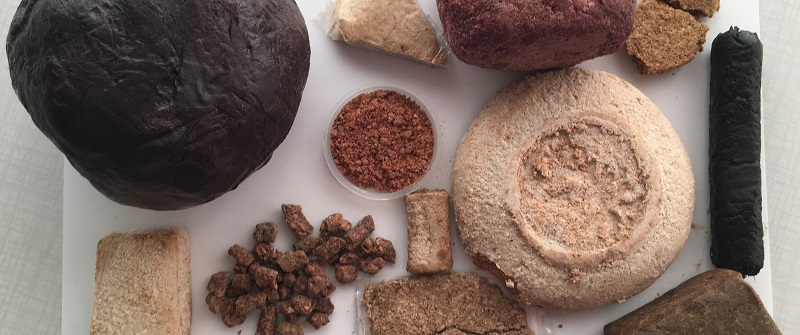
23 Feb Blog | Smells bad, looks ugly but it’s delicious!
By Mery Tambaria Damanik Ambarita.
Talking about terasi, the shrimp or seafood paste (fermented) from Indonesia, opens up many avenues of discussion. Such was my experience when I did my research on terasi for my PhD in Belgium. During my Bachelor’s student days in Bogor, I never consumed sambal-terasi, the chili sauce made with terasi, because I was hardly at home and I never prepared food that required terasi.
During my study I collected and analyzed hundreds of samples and I experienced various reactions to this “extraordinary smell”. In the first weeks when I carried out my laboratory analysis, staff who visited were confused about the source of the penetrating smell hanging in the air. Even in simple tasks for example weighing the sample of terasi, there would be an unexplainable odour. As a next step of my analysis, I started the process of drying several samples and the smell started to spread throughout the entire floor and even to another laboratory across mine. Because of the large size of samples, and limited lab time, my work was quite intensive. Slowly but surely, almost all the occupants of the six-story building began to ask questions about this strange smell.
I myself was unfamiliar with terasi, had not come in to contact with it before my Indonesian adventure, or used it before. My first experience with terasi was when I had just started my career as a lecturer in at the Food Technology Department at a university in Tangerang, a city next to Jakarta. At that time I rented a room close to the university. It turned out that almost every morning I would be woken up by this smell of terasi because my room happened to be close to the kitchen. One of the residents at the boarding house almost always cooked with terasi; be it tofu, tempeh or vegetables, she always added terasi. One day she offered me her food that she had prepared. I was surprised, even though there was no meat or fish, the food tasted like it contained these protein ingredients and believe me, it was delicious! My palate, which is accustomed to the North Sumatran cuisine, tends to favor spicy, savory and salty food, which is a little different from my friend who was from Yogyakarta, where the cuisine tends to be sweeter and less spicy. From here I started to hone my experience regarding flavor profiles discovering new tastes and flavors from various places and countries. This was one of the reasons for my decision to conduct my PhD on this particular condiment. During my PhD study I became part of a team of trained panelists for taste/flavor profiles at my university in Belgium. This helped me to relate the tast/flavor of sambal-terasi to the chemical composition of terasi.
As it turns out, mention of terasi is found in old texts for example in the Serat Centhini (a compilation of Javanese tales and teaching written in verse).
We can also find the use of terasi in some colonial cookbooks, and this condiment was even included in recipe books by Dutch authors. This shows that this condiment has been around for a long time in Indonesian and even in the Dutch culinary cuisines, for example, the rijsttafel which has recently has been included in the Dutch list of the UNESCO Memory of the World register. Even some cheese sold in the Netherlands has a sambal trassie flavor. We also find the use of terasi in Suriname by the descendants of the Javanese contract workers that were transported to Suriname by the Dutch colonial government to work at the plantations and mines. The Surinamese Javanese continued to practice and live their culture, maintaining the taste/flavor of their original cuisine. It’s interesting how the Indonesian diaspora has brought this condiment to many places in the world. Many Indonesian migrants still use this terasi paste in their kitchen, including those in the Netherlands.
One advantage of studying this condiment in Belgium is the different perspectives from other nations, for example I learn how to conduct gastro diplomacy among Belgian people who are not familiar with this material. I also noticed that many products like terasi are used by students from Southeast Asia.
One of the main findings from my research is the complexity of the chemical characteristics of the samples collected from various provinces in Indonesia. It turns out that each manufacturer also had its own way in handling the raw materials and different production processes. The final product varies regionally in quality because of the different drying, storage, aging times. It is evident that these different variations of terasi have a different impact on the taste and flavor when used in certain types of food. That’s why for instance, the taste of sambal-terasi differs throughout the archipelago.
The level of complexity exuded by each variety of terasi is still perceivable even though some smells inevitably evaporates during cooking. Thus, you have to be familiar with the terasi you like (and its characteristics) and you have to know how to highlight the advantages and mask the disadvantages of a particular variety of terasi when cooking your favorite Indonesian dishes. As the saying in Indonesia, “tak kenal maka tak sayang” (if you don’t know it, you won’t love it). In other words, don’t judge the book by its cover, or in Dutch: wat de boer niet kent, eet hij niet. In my case, in the beginning it smelled bad, looked ugly, but if you know to prepare and use terasi in dishes, it’s delicious!
Dr. Mery Tambaria Damanik Ambarita has published on the chemical characteristics and sensory attributes of terasi. Her thesis can be read here.
Photo caption: Different types of terasi. Courtesy of Mery Tambaria Damanik Ambarita.




No Comments